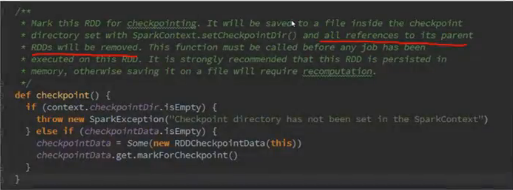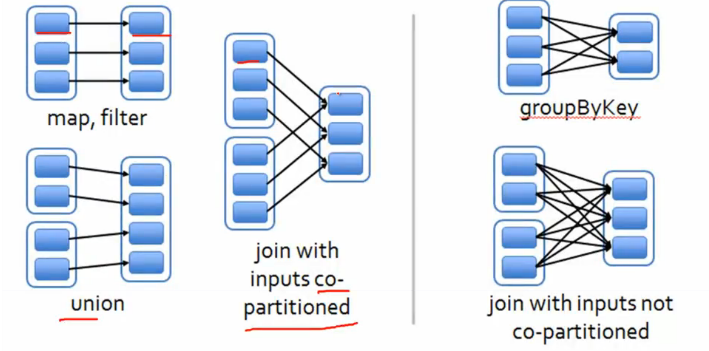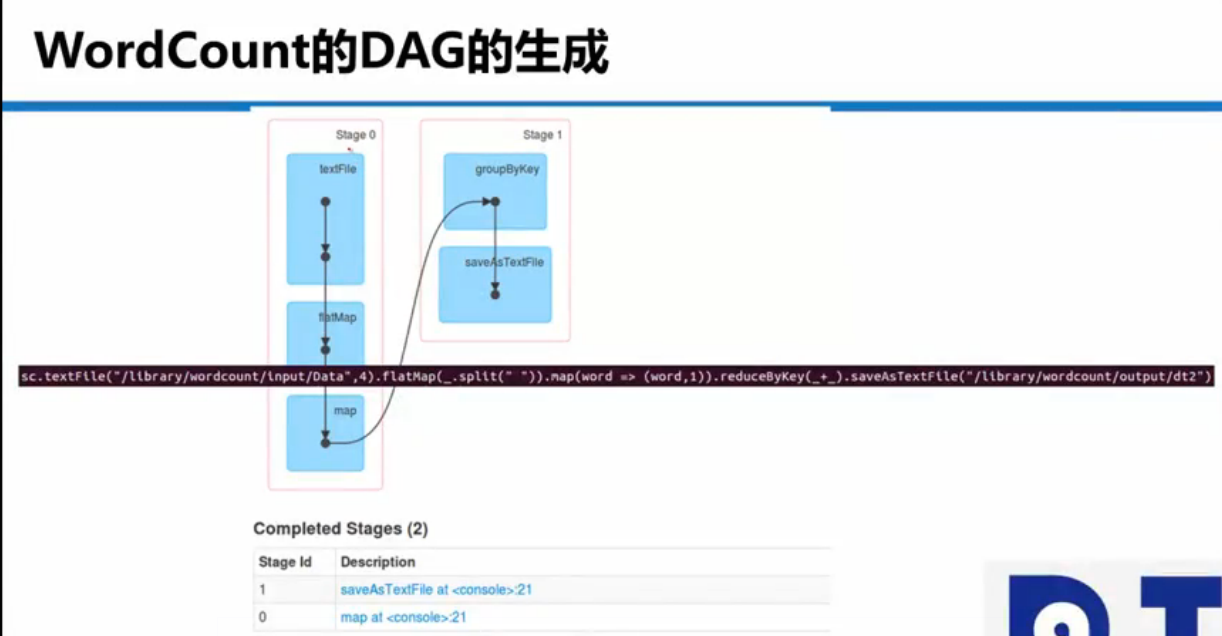@hadoopMan
2017-03-04T14:27:58.000000Z
字数 9176
阅读 1160
RDD介绍
spark
想学习spark,hadoop,kafka等大数据框架,请加群459898801,满了之后请加2群224209501。后续文章会陆续公开
RDD 操作
1,RDD五大特点:
1,A list of partions
一系列的分片:比如64M一个分片,类似于hadoop的splits。
2,A function for computing each split
在每个分区上都有一个函数去迭代、执行、计算它。
3,A list dependancies on other RDDS
一系列的依赖:RDDa转换为RDDb,RDDb转换为RDDc;那么就是RDDc依赖于RDDb,RDDb依赖于RDDa。
4,Optionally,a Partioner for key-value RDDs(e.g。to say that the RDD is hash-partioned)
对于key-value的RDD可以指定一个Partioner,来告诉他如何进行分片;常用的有hash,range。
5,Optionally,a list of preferred location(s) to compute each split on (e.g.block locations for an HDFS file)
要运行的计算/执行最好在哪(几)个机器上运行。数据的本地性。
比如:hadoop,默认位置有三个,或者spark cache到内存是可能通过StorageLevel设置了多个副本,所以一个partion可能返回多个最佳位置。
2,RDDs的2 种类型的操作
RDDs 支持 2 种类型的操作:转换(transformations) 从已经存在的数据集中创建一个新的数据集;动作(actions) 在数据集上进行计算之后返回一个值到驱动程序。例如,map 是一个转换操作,它将每一个数据集元素传递给一个函数并且返回一个新的 RDD。另一方面,reduce 是一个动作,它使用相同的函数来聚合 RDD 的所有元素,并且将最终的结果返回到驱动程序(不过也有一个并行 reduceByKey 能返回一个分布式数据集)。
在 Spark 中,所有的转换(transformations)都是惰性(lazy)的,它们不会马上计算它们的结果。相反的,它们仅仅记录转换操作是应用到哪些基础数据集(例如一个文件)上的。转换仅仅在这个时候计算:当动作(action) 需要一个结果返回给驱动程序的时候。这个设计能够让 Spark 运行得更加高效。例如,我们可以实现:通过map 创建一个新数据集在 reduce 中使用,并且仅仅返回 reduce 的结果给 driver,而不是整个大的映射过的数据集。
默认情况下,每一个转换过的 RDD 会在每次执行动作(action)的时候重新计算一次。然而,你也可以使用persist (或 cache)方法持久化(persist)一个 RDD 到内存中。在这个情况下,Spark 会在集群上保存相关的元素,在你下次查询的时候会变得更快。在这里也同样支持持久化 RDD 到磁盘,或在多个节点间复制。
3,Transformations函数
| Transformation | Meaning |
|---|---|
| map(func) | Return a new distributed dataset formed by passing each element of the source through a function func. |
| filter(func) | Return a new dataset formed by selecting those elements of the source on which func returns true. |
| flatMap(func) | Similar to map, but each input item can be mapped to 0 or more output items (so func should return a Seq rather than a single item). |
| mapPartitions(func) | Similar to map, but runs separately on each partition (block) of the RDD, so func must be of type Iterator => Iterator when running on an RDD of type T. |
| mapPartitionsWithIndex(func) | Similar to mapPartitions, but also provides func with an integer value representing the index of the partition, so func must be of type (Int, Iterator) => Iterator when running on an RDD of type T. |
| sample(withReplacement, fraction, seed) | Sample a fraction fraction of the data, with or without replacement, using a given random number generator seed. |
| union(otherDataset) | Return a new dataset that contains the union of the elements in the source dataset and the argument. |
| intersection(otherDataset) | Return a new RDD that contains the intersection of elements in the source dataset and the argument. |
| distinct([numTasks])) | Return a new dataset that contains the distinct elements of the source dataset. |
| groupByKey([numTasks]) | When called on a dataset of (K, V) pairs, returns a dataset of (K, Iterable) pairs. Note: If you are grouping in order to perform an aggregation (such as a sum or average) over each key, using reduceByKey or aggregateByKey will yield much better performance. Note: By default, the level of parallelism in the output depends on the number of partitions of the parent RDD. You can pass an optional numTasks argument to set a different number of tasks. |
| reduceByKey(func, [numTasks]) | When called on a dataset of (K, V) pairs, returns a dataset of (K, V) pairs where the values for each key are aggregated using the given reduce function func, which must be of type (V,V) => V. Like in groupByKey, the number of reduce tasks is configurable through an optional second argument. |
| aggregateByKey(zeroValue)(seqOp, combOp, [numTasks]) | When called on a dataset of (K, V) pairs, returns a dataset of (K, U) pairs where the values for each key are aggregated using the given combine functions and a neutral "zero" value. Allows an aggregated value type that is different than the input value type, while avoiding unnecessary allocations. Like in groupByKey, the number of reduce tasks is configurable through an optional second argument. |
| sortByKey([ascending], [numTasks]) | When called on a dataset of (K, V) pairs where K implements Ordered, returns a dataset of (K, V) pairs sorted by keys in ascending or descending order, as specified in the boolean ascending argument. |
| join(otherDataset, [numTasks]) | When called on datasets of type (K, V) and (K, W), returns a dataset of (K, (V, W)) pairs with all pairs of elements for each key. Outer joins are supported through leftOuterJoin, rightOuterJoin, and fullOuterJoin. |
| cogroup(otherDataset, [numTasks]) | When called on datasets of type (K, V) and (K, W), returns a dataset of (K, (Iterable, Iterable)) tuples. This operation is also called groupWith. |
| cartesian(otherDataset) | When called on datasets of types T and U, returns a dataset of (T, U) pairs (all pairs of elements). |
| pipe(command, [envVars]) | Pipe each partition of the RDD through a shell command, e.g. a Perl or bash script. RDD elements are written to the process's stdin and lines output to its stdout are returned as an RDD of strings. |
| coalesce(numPartitions) | Decrease the number of partitions in the RDD to numPartitions. Useful for running operations more efficiently after filtering down a large dataset. |
| repartition(numPartitions) | Reshuffle the data in the RDD randomly to create either more or fewer partitions and balance it across them. This always shuffles all data over the network. |
| repartitionAndSortWithinPartitions(partitioner) | Repartition the RDD according to the given partitioner and, within each resulting partition, sort records by their keys. This is more efficient than calling repartition and then sorting within each partition because it can push the sorting down into the shuffle machinery. |
action
4,Action函数
| Action | Meaning |
|---|---|
| reduce(func) | Aggregate the elements of the dataset using a function func (which takes two arguments and returns one). The function should be commutative and associative so that it can be computed correctly in parallel. |
| collect() | Return all the elements of the dataset as an array at the driver program. This is usually useful after a filter or other operation that returns a sufficiently small subset of the data. |
| count() | Return the number of elements in the dataset. |
| first() | Return the first element of the dataset (similar to take(1)). |
| take(n) | Return an array with the first n elements of the dataset. |
| takeSample(withReplacement, num, [seed]) | Return an array with a random sample of num elements of the dataset, with or without replacement, optionally pre-specifying a random number generator seed. |
| takeOrdered(n, [ordering]) | Return the first n elements of the RDD using either their natural order or a custom comparator. |
| saveAsTextFile(path) | Write the elements of the dataset as a text file (or set of text files) in a given directory in the local filesystem, HDFS or any other Hadoop-supported file system. Spark will call toString on each element to convert it to a line of text in the file. |
| saveAsSequenceFile(path) (Java and Scala) | Write the elements of the dataset as a Hadoop SequenceFile in a given path in the local filesystem, HDFS or any other Hadoop-supported file system. This is available on RDDs of key-value pairs that either implement Hadoop's Writable interface. In Scala, it is also available on types that are implicitly convertible to Writable (Spark includes conversions for basic types like Int, Double, String, etc). |
| saveAsObjectFile(path) (Java and Scala) | Write the elements of the dataset in a simple format using Java serialization, which can then be loaded using SparkContext.objectFile(). |
| countByKey() | Only available on RDDs of type (K, V). Returns a hashmap of (K, Int) pairs with the count of each key. |
| foreach(func) | Run a function func on each element of the dataset. This is usually done for side effects such as updating an accumulator variable (see below) or interacting with external storage systems. |
RDD 持久化
1,持久化介绍
Spark最重要的一个功能是它可以通过各种操作(operations)持久化(或者缓存)一个集合到内存中。当你持久化一个RDD的时候,每一个节点都将参与计算的所有分区数据存储到内存中,并且这些 数据可以被这个集合(以及这个集合衍生的其他集合)的动作(action)重复利用。这个能力使后续的动作速度更快(通常快10倍以上)。对应迭代算法和快速的交互使用来说,缓存是一个关键的工具。
你能通过persist()或者cache()方法持久化一个rdd。首先,在action中计算得到rdd;然后,将其保存在每个节点的内存中。Spark的缓存是一个容错的技术-如果RDD的任何一个分区丢失,它 可以通过原有的转换(transformations)操作自动的重复计算并且创建出这个分区。
此外,我们可以利用不同的存储级别存储每一个被持久化的RDD。例如,它允许我们持久化集合到磁盘上、将集合作为序列化的Java对象持久化到内存中、在节点间复制集合或者存储集合到 Tachyon中。我们可以通过传递一个StorageLevel对象给persist()方法设置这些存储级别。cache()方法使用了默认的存储级别—StorageLevel.MEMORY_ONLY。完整的存储级别介绍如下所示:
| Storage Level | Meaning |
|---|---|
| MEMORY_ONLY | 将RDD作为非序列化的Java对象存储在jvm中。如果RDD不适合存在内存中,一些分区将不会被缓存,从而在每次需要这些分区时都需重新计算它们。这是系统默认的存储级别。 |
| MEMORY_AND_DISK | 将RDD作为非序列化的Java对象存储在jvm中。如果RDD不适合存在内存中,将这些不适合存在内存中的分区存储在磁盘中,每次需要时读出它们。 |
| MEMORY_ONLY_SER | 将RDD作为序列化的Java对象存储(每个分区一个byte数组)。这种方式比非序列化方式更节省空间,特别是用到快速的序列化工具时,但是会更耗费cpu资源—密集的读操作。 |
| MEMORY_AND_DISK_SER | 和MEMORY_ONLY_SER类似,但不是在每次需要时重复计算这些不适合存储到内存中的分区,而是将这些分区存储到磁盘中。 |
| DISK_ONLY | 仅仅将RDD分区存储到磁盘中 |
| MEMORY_ONLY_2, MEMORY_AND_DISK_2, etc. | 和上面的存储级别类似,但是复制每个分区到集群的两个节点上面 |
| OFF_HEAP (experimental) | 以序列化的格式存储RDD到Tachyon中。相对于MEMORY_ONLY_SER,OFF_HEAP减少了垃圾回收的花费,允许更小的执行者共享内存池。这使其在拥有大量内存的环境下或者多并发应用程序的环境中具有更强的吸引力。 |
NOTE:在python中,存储的对象都是通过Pickle库序列化了的,所以是否选择序列化等级并不重要。
Spark也会自动持久化一些shuffle操作(如reduceByKey)中的中间数据,即使用户没有调用persist方法。这样的好处是避免了在shuffle出错情况下,需要重复计算整个输入。如果用户计划重用计算过程中产生的RDD,我们仍然推荐用户调用persist方法。
2,使用时机
1,大量数据的输入的时候,包括从文件系统读取或者shuffle获取
2,计算比较耗时的RDD
3,链条比较长的
4,cheakpoint的时候
主要是避免缓存丢失要重新计算带来的性能的开销

3,如何选择存储级别
Spark的多个存储级别意味着在内存利用率和cpu利用效率间的不同权衡。我们推荐通过下面的过程选择一个合适的存储级别:
- MEMORY_ONLY
如果你的RDD适合默认的存储级别(MEMORY_ONLY),就选择默认的存储级别。因为这是cpu利用率最高的选项,会使RDD上的操作尽可能的快。 - MEMORY_ONLY_SER
如果不适合用默认的级别,选择MEMORY_ONLY_SER。选择一个更快的序列化库提高对象的空间使用率,但是仍能够相当快的访问。 - 除非函数计算RDD的花费较大或者它们需要过滤大量的数据,不要将RDD存储到磁盘上,否则,重复计算一个分区就会和重磁盘上读取数据一样慢。
- 如果你希望更快的错误恢复,可以利用重复(replicated)存储级别。所有的存储级别都可以通过重复计算丢失的数据来支持完整的容错,但是重复的数据能够使你在RDD上继续运行任务,而不需要重复计算丢失的数据。
在拥有大量内存的环境中或者多应用程序的环境中,OFF_HEAP具有如下优势:
1,它运行多个执行者共享Tachyon中相同的内存池
2,它显著地减少垃圾回收的花费
3,如果单个的执行者崩溃,缓存的数据不会丢失
4,删除数据
Spark自动的监控每个节点缓存的使用情况,利用最近最少使用原则删除老旧的数据。如果你想手动的删除RDD,可以使用RDD.unpersist()方法
窄依赖和宽依赖,
1,窄依赖:
一个窄依赖在一个stage
1,每一个parentRDD的RDDpartition只能被一个子RDDpartition使用
2,输入输出一对一的算子,且结果RDD的分区结构不变,主要是map、flatmap
3,输入输出一对一,淡结果RDD的分区结构发生变化,如union、coaesce
4,从输入中选择部分元素的原子,如filter、distinct、subtract、sample
2,宽依赖
1,子RDD的每个分区依赖于所有父RDD分区。
2,对于单个RDD基于key进行重组和reduce,如groupByKey,reduceByKey;
3,对于两个RDD基于key进行join和重组,如join

stage里面计算是并行的,因为互相独立

resultTask和shuffleMapTask
A ShuffleMapTask divides the elements of an RDD into multiple buckets (based on a partitionerspecified in the ShuffleDependency).
A task that sends back the output to the driver application.
